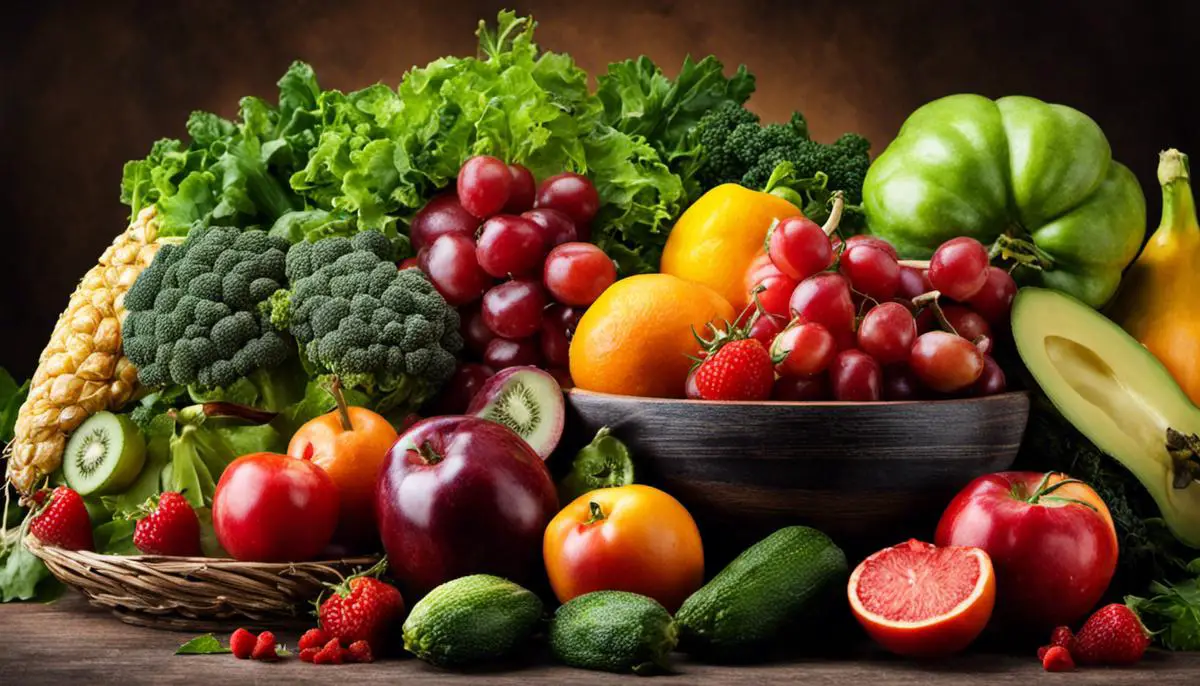In the contemporary world, the focus on a healthy lifestyle has intrinsically linked our daily diets to a clear understanding of the calorie count in food. This understanding is pivotal not only for weight control, but also for maintaining overall health and wellness. This discourse will delve into the key components of this broad topic – starting from comprehending the complex composition of food, to being able to effortlessly decipher nutrition labels, and finally, effectively using digital tools and apps to keep track of your calorie intake effortlessly. The primary focus will be on the three macro-nutrients – carbohydrates, proteins, and fats, all of which play major roles in determining the calorie content in food. Furthermore, the discussion will also expose you to an extensive range of digital resources which can enhance your ability to calculate and track caloric quantities in various foods efficiently and accurately.
Understanding Food composition
The Basic Components of Food and Their Contribution to Caloric Content
As food’s intricate nature intertwines with life’s fundamental processes, it can be an area of both wonder and complexity. The exploration begins with understanding the primary components of food and their direct influence on its caloric value.
Food, the driving force of life, consists of a myriad of components. However, the basic constituents being carbohydrates, fats, protein, water, minerals, and vitamins fall under intense scrutiny in the discussion of caloric content.
Carbohydrates, derived from an array of sources such as fruits, vegetables, and grains, generally provide four calories per gram. They effectively serve as the body’s prime source of energy. Simple carbohydrates, like sugars, present instant energy. In contrast, complex carbohydrates like fiber undergo slower metabolization, offering longer-lasting power.
Notably, fats represent the densest caloric component, providing nine calories per gram. Originating from assorted sources such as oils, nuts, and animal products, fat is essential for the healthy functioning of the body. It cushions organs, insulates the body, and aids in absorbing fat-soluble vitamins like A, D, E, and K. However, excessive intake or intake of unhealthy fats can lead to obesity and heart-related ailments.
In a similar vein to carbohydrates, proteins also deliver four calories per gram. Mainly found in food items like meat, dairy, beans, and nuts, proteins are the building blocks of cells and tissue. They facilitate muscle repair and growth while playing a pivotal role in the production of enzymes and hormones.
Water, while bearing no caloric significance, is an essential component of food. It serves as a transport mechanism for nutrients, aids in waste removal, and helps maintain overall body temperature.
Minerals and vitamins, albeit bearing no calories, serve as potent facilitators of crucial metabolic processes. These include cellular function, bone health, immune system regulation, and neural function. Therefore, even though they do not directly contribute to the total caloric value of food, they significantly affect overall health and well-being and should never be overlooked in dietary considerations.
Insight into the basic components of food and their contribution to its caloric content is an essential stride in understanding our nourishment needs. It further paves the way towards comprehensive knowledge about dietary requirements and the role of food in health and wellness. Understanding these components hints at the depth of food’s complexity and opens a window into the world of nutrition science, fostering greater appreciation for every morsel consumed.

Reading and interpreting nutrition labels
Delving Deeper into Reading and Interpreting Nutrition Labels: A Precise Look at Calorie Assessment
Profoundly comprehension of the components of food and their calorific contributions highlights the importance of deciphering nutrition labels. The syntax in these labels serves as a coded message that, once de-coded, offers a comprehensive understanding of the calorie content of the food.
The energy provided by food—expressed as calories—is captured on nutrition labels. This information is typically provided per serving and per 100 grams or milliliters. Here’s a crucial thing to remember: the caloric content listed is for a single serving—not the whole package. Misinterpreting this common misconception can lead to an unintentional intake of excessive calories. Therefore, always cross-reference the serving size to comprehend the aggregate caloric content.
Dissecting the caloric composition is the following step. Nutrition labels enumerate the grams of fat, carbohydrates, and proteins contributing to the overall calories. To compute the total calories from each nutrient, utilize these thumb rules: 9 calories per gram of fat, 4 calories per gram of carbohydrate, and 4 calories per gram of protein.
The percent daily value (%DV) is another useful tool for gauging calorie content. The %DV indicates the percentage of the recommended daily intake of a nutrient based on a 2,000-calorie diet. But caution is advised. The needs widely vary based on factors including age, sex, weight, and physical activity level—consequently, individualizing the %DV becomes essential.
Dietary fiber, though a subset of carbohydrates, bears a special mention. Unlike other carbohydrates, it isn’t absorbed, hence contributes zero calories. A high fiber %DV denotes a filling meal with minimal caloric content—an ideal for those pursuing weight management.
Shifting attention to sugars, ‘Total Sugars’ account for both naturally-occurring and added sugars. Whereas, ‘Added Sugars’ exclusively indicate sugars that aren’t naturally part of the food. Excessive consumption of added sugars can significantly increase calorie intake without having substantive nutritive value.
‘Calories from Fat’ had been phased out of nutrition labels since 2018, as studies indicate the type of fat is more critical than the total fat amount. So, trans fats in nutrition labels require diligent watch since, despite providing the same calories as other fats, they significantly enhance cardiovascular risk.
The next label element, ‘Cholesterol,’ unlike the others, doesn’t contribute to immediate calorie content but is pertinent for calorie-laden foods. High cholesterol food items are often rich in saturated fats—a similar case applies to ‘Sodium.’
Evidently, reading and interpreting nutrition labels, while fascinatingly complex, is indispensable for an accurate calorie assessment. It not only deciphers the energy content but also reveals the nature of that energy. The process becomes an essential tool to foster mindful food choices, meeting individual calorie needs, and ultimately improving overall health.

Using digital tools and apps
The quest for accurate and precise dietary intake information is an essential element for proper nutrition management and assessment. To this end, numerous digital tools and applications have emerged to empower individuals to track food calories with optimal accuracy. These are also pivotal for registered dieticians, nutritionists, and health conscious individuals in executing meal planning and dietary control.
One of these innovative tools is MyFitnessPal, a multifaceted application that allows tracking of caloric intake, exercise, and weight goals. MyFitnessPal’s extensive food database includes over six million foods, complete with details on calorie and nutrient contents. It is also equipped with a barcode scanner for easy logging of packaged foods. The app aligns perfectly with modern nutritional sciences due to its ability to provide insight into macronutrient balances in user’s diets.
Equally as robust, Cronometer is another free application that offers sophisticated tracking capabilities. Cronometer stands out for its focus on micronutrient intake, providing exhaustive data on vitamins and minerals in addition to standard aspects like calories and macronutrients. Its analytics feature also yields graphs and trends of calorie and nutrient intake over extended periods, making it ideally suited for longitudinal nutritional assessment.
Those with a penchant for wholesome organic diets may find Fooducate a favorable option. This application goes beyond counting calories; it grades foods based on their nutritional value and provides alternative suggestions. This encourages users to make healthier food choices beyond mere calorie restriction, which aligns well with the principles of holistic nutrition.
Nutritionix Track is worth mentioning for its unique characteristic: voice recognition. This functionality facilitates the entry of customized and home-cooked meals, addressing a common challenge in accurate calorie counting. Moreover, Nutritionix Track collaborates with restaurants, food manufacturers, and universities to maintain a reliable food database.
For health professionals, apps like Protracker Plus offer advanced features like a nutrient breakdown for meal planning and engendering informed client discussions. Its built-in food diary also assists in visualizing and controlling food portions, aligning with the realization that controlling portion sizes is crucial to managing caloric intake.
In the ever-advancing world of science and technology, these digital tools and applications offer promising avenues for accurate calorie counting, meal planning, and optimal weight management. Despite the notion that they are mere tools, the value they add to our understanding and management of nutrition is immense. It is, however, to be remembered that though they aid in precise measurements and goal setting, the ultimate milestone in optimal nutrition lies in well-informed, consistent dietary habits. The power of dietary science melded with these cutting-edge digital tools provides us with not only information and understanding, but also the empowerment to control, manipulate, and improve our dietary patterns for overall health and wellness.

After gaining a lucid understanding of the food composition and the role of each macro-nutrient in contributing to the calorie count, it becomes paramount to understand how this knowledge can be applied practically. Through the art of reading and interpreting nutrition labels, one can accurately gauge their calorie consumption even with different serving sizes. Coupled with this, the advent of digital tools and apps has revolutionized the ease with which one can keep track of their daily calorie intake. Combining traditional knowledge with contemporary technology brings about a harmonized approach towards a healthier diet, enabling you to live a more balanced and healthier life. The end goal is to equip you with the knowledge and resources to make more informed decisions about your food choices and intake, taking a significant stride towards a healthier lifestyle.

